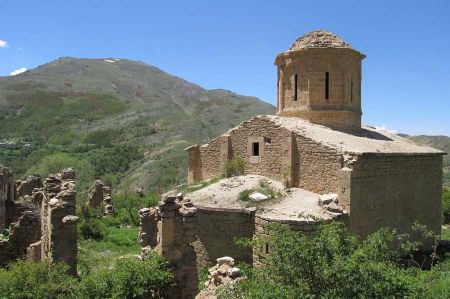Trabzon – events and stations in history
- Written by Portal Editor
Trabzon, known in Greek as Trapezous, is located in the north-east of Turkey and is the easternmost Turkish port city on the Black Sea. Today, as the Greek name suggests, Trabzon was a middle economic center and a transshipment point for the export of hazelnuts, tea and tobacco, and a place steeped in history.
The region around Trabzon was already inhabited by the Hittites, and Hittite names such as Hajaša or Azzi are known from records. The Assyrians who later lived here formed the first trading colonies that stretched from the Black Sea across the Pontic Taurus Mountains to the Iranian highlands. With the settlement of Mycenaean Greeks in the late Bronze Age and their contacts with the local population, a lively trade in the coveted mineral resources gold, silver and lead developed, which often enough also formed the background of mythological tales. The myth of the Golden Fleece and the mythological tales of Iason are said to have originated in the region around Trabzon in the 12th century BC.
The first Greek settlers at Trabzon probably came from the already established Greek colony at Sinop. Around 756 BC they were already trading in iron and silver, which was mined here by the locals. These Greek trading colonies existed like small enclaves along the Black Sea coast, extending only a little inland. Thus there was little contact with the Urartu Empire, which controlled large parts of Anatolia. The records of the Greek historian Herodotus contain texts on the conquests of the Caucasian Cimmerians, who were able to conquer both Trabzon, then known as the Trapezos, and large parts of the coast. Far into the hinterland, the Cimmerians carried out plundering raids again and again until they were finally beaten back in the reign of the New Assyrian ruler Assurbanipal between 669 and 627 BC.
Trabzon in the Persian Empire under King Cyrus
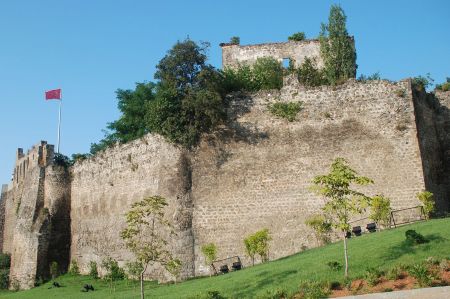 Around the year 546 BC, the Achaemenid king Cyrus II was able to conquer the eastern Black Sea region and thus declare it part of the Persian Empire. Family quarrels, also about the succession to the throne, even led to armed conflicts between Artaxerxes II and Cyrus, which ended in the battle of Kunaxa, which is about 80 kilometers north of Babylon on the Euphrates. The battle was not lost only through the death of Cyrus. More than 10,000 Greek soldiers and mercenaries from Cyrus' army then withdrew through Armenia to the port of Trabzon. The old and sick were embarked here and transported back to Greece. The remaining troops moved back to their homeland along the Black Sea.
Around the year 546 BC, the Achaemenid king Cyrus II was able to conquer the eastern Black Sea region and thus declare it part of the Persian Empire. Family quarrels, also about the succession to the throne, even led to armed conflicts between Artaxerxes II and Cyrus, which ended in the battle of Kunaxa, which is about 80 kilometers north of Babylon on the Euphrates. The battle was not lost only through the death of Cyrus. More than 10,000 Greek soldiers and mercenaries from Cyrus' army then withdrew through Armenia to the port of Trabzon. The old and sick were embarked here and transported back to Greece. The remaining troops moved back to their homeland along the Black Sea.
Only a little later Trapezos was besieged by Scythian horse nomads. Supposedly at this time there was a duty of tribute to Sinop, as mentioned in the records of Xenophon. When Alexander the Great was able to crush the Persians during the Battle of Issus in 333 BC, the expansion of the great empire along the Black Sea coast was also associated with it. After the death of Alexander in 323 BC, the Greek Mithridates I founded the kingdom of Pontos in 301 BC with Trabzon as its capital and important port city. In the years to come, the respective kings were able to extend their sphere of power to the borders of the Roman Empire. The last great ruler of the kingdom of Pontus was Mithridates VI Eupator, who ruled the kingdom from 120-63 BC.
Roman Emperor Hadrian defeats the Kingdom of Pontus
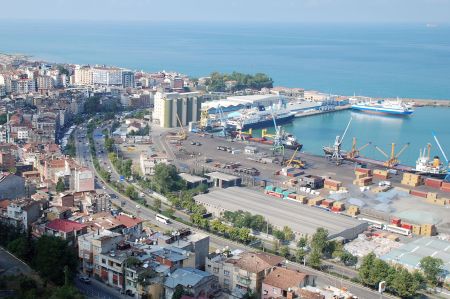 In three great wars, appropriately called the Mithridatic Wars, the kingdom of Pontus was finally defeated by the Romans and their allies, and the entire Black Sea coast was annexed to the Roman Empire as the province of Bithnya et Pontus.
In three great wars, appropriately called the Mithridatic Wars, the kingdom of Pontus was finally defeated by the Romans and their allies, and the entire Black Sea coast was annexed to the Roman Empire as the province of Bithnya et Pontus.
Under Emperor Hadrian, who ruled the Roman Empire from 117 to 138 AD, Trabzon was expanded to become the provincial capital of Bithnya et Pontus. The expansion of the port in connection with the shipbuilding that took place there made Trabzon world famous. The Romans had also built a military road along the Black Sea that led as far as Trabzon before branching off to the southwest and continuing to the imperial border on the Syrian Euphrates. The upper citadel and the middle part of the former city fortifications were also built and improved by the Romans.
In the year 258 BC, large parts of the city of Trabzon were destroyed in military conflicts with advancing Goths, which, however, were quickly rebuilt by the Romans. Until the 4th century Trabzon was the seat of a Roman governor and site of the Legio I Pontica. With the spread of Christianity, local residents built a variety of monasteries and churches. In early Byzantine times, Emperor Justinian also had the city walls of Trabzon reinforced. However, with the exception of St. Anna's Church from 884 - 885, there are no more structural remains from this period. The inhabitants of Trabzon were able to successfully fend off the first Seljuk attacks in the 10th century. The attractiveness of trade through its own port alone brought Trabzon another period of prosperity. This heyday was particularly evident under Emperor Basileios (976 – 1025), because he had numerous churches built that are mentioned in documents.
Constantinople becomes the capital
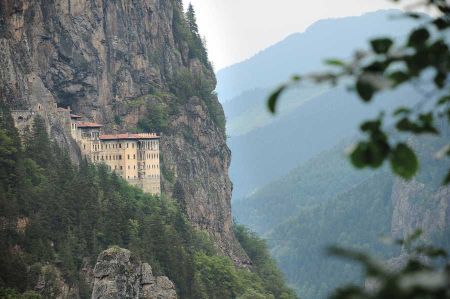 In 1204, the army of the Fourth Crusade attacked, which not only smashed the Byzantine Empire, but also established the Latin Empire in Constantinople, which was very surprising for Byzantium. As a successor state to the Byzantine Empire, Trabzon was also established as the capital of a separate empire under the leadership of the Byzantine ruling dynasty of the Komnenen. The two grandsons of Emperor Andronikos I, Alexios and David Komnenos, from the court of Queen Tamar in Georgia, had sought and found great support. In 1204, Alexios I became emperor of Trebizond, while his younger brother tried to establish an empire there after conquering Sinop. His push west was stopped by the Empire of Nicaia.
In 1204, the army of the Fourth Crusade attacked, which not only smashed the Byzantine Empire, but also established the Latin Empire in Constantinople, which was very surprising for Byzantium. As a successor state to the Byzantine Empire, Trabzon was also established as the capital of a separate empire under the leadership of the Byzantine ruling dynasty of the Komnenen. The two grandsons of Emperor Andronikos I, Alexios and David Komnenos, from the court of Queen Tamar in Georgia, had sought and found great support. In 1204, Alexios I became emperor of Trebizond, while his younger brother tried to establish an empire there after conquering Sinop. His push west was stopped by the Empire of Nicaia.
In 1204 traders from Genoa also founded a colony in Trebizond, in 1289 another colony in Amisos, which is now called Samsun, and a third colony from 1301 in Sinop. With the expansion of these trading colonies, economic power passed more and more to the Genoese. When the Venetians founded a trading post in Trebizond in 1319, a competitive situation was created again for the first time.
Despite the incursion of Mongol cavalry troops in the mid-13th century, the city continued to 'boom' due to very lucrative trade and the resulting tariffs. Trabzon became the hub of trade between Russia, the Mediterranean and the Middle East. The Venetians now increasingly came to the fore, and with their excellent trading posts they became Trebizond's biggest sponsors.
Magnificent buildings could be put into practice at this time, including the famous Hagia Sophia of Trabzon, a still magnificent church in the middle of the city. Approaching Trabzon from the west, on a cliff above the coastal road, one sees first the tower and then the church of Hagia Sophia, built in 1238-1263. Compared to the Hagia Sophia in Istanbul, this church is very small, but fascinates with its wall paintings from the 13th century and restored in the 1950s.
Trebizond - a stronghold of Greek culture
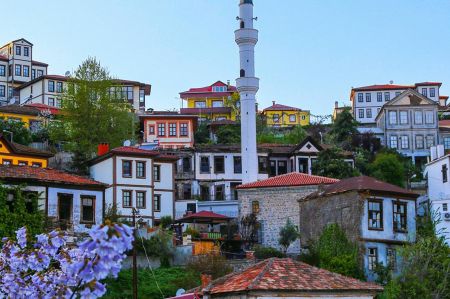 Now the climax of power at the court of the Komnenen had been reached. Trebizond had matured into a center of culture and art, a refuge for Greek culture in Asia Minor. Many of the churches and monasteries that can still be admired today date from this period. And as so often in history, the course of events is repeated in Trebizond: the collapse of power of the Komnene dynasty due to internal intrigues and civil wars. The increasing Turkish raids did the rest. Although still an important trading center up until the middle of the 15th century, Trabzon steadily lost importance.
Now the climax of power at the court of the Komnenen had been reached. Trebizond had matured into a center of culture and art, a refuge for Greek culture in Asia Minor. Many of the churches and monasteries that can still be admired today date from this period. And as so often in history, the course of events is repeated in Trebizond: the collapse of power of the Komnene dynasty due to internal intrigues and civil wars. The increasing Turkish raids did the rest. Although still an important trading center up until the middle of the 15th century, Trabzon steadily lost importance.
With the fall of the Kingdom of Armenia, more and more Armenians had come to Trabzon. Especially in the second half of the 14th century, the number of refugees from the doomed city of Ani increased significantly. Years of fighting around Sivas had caused many citizens to flee. In Trabzon the Armenians tried to find a new homeland. The construction of the Kaymaklı Monastery on Boztepe Hill southeast of the city center is a remnant of Armenian architecture from that period.
Even after Constantinople was conquered by the Turks in 1453, the Trebizond Empire survived for a few years, although it was now under Ottoman rule. However, the last ruler of Trebizond, David Komnenos, had to cede his rule to Mehmet II in 1461 after a last attempt at an alliance of all Greek states against the sultan to restore a Byzantine empire had failed. The imperial family was taken to Constantinople and executed by strangulation there. Large parts of the wealthy residents of Trebizond were forcibly relocated to Constantinople by Mehmet, others were enslaved to the army. About 800 young residents of Trebizond were incorporated into the Janissary corps. Only the predominantly poor inhabitants of the port region remained in Trebizond, the military took over the upper fortress and the fortified middle city level. Hardly any new buildings were erected up until the 19th century. Many of the existing churches were converted into mosques, Trebizond became the Eyâlet Trabosan.
Please read as well:
